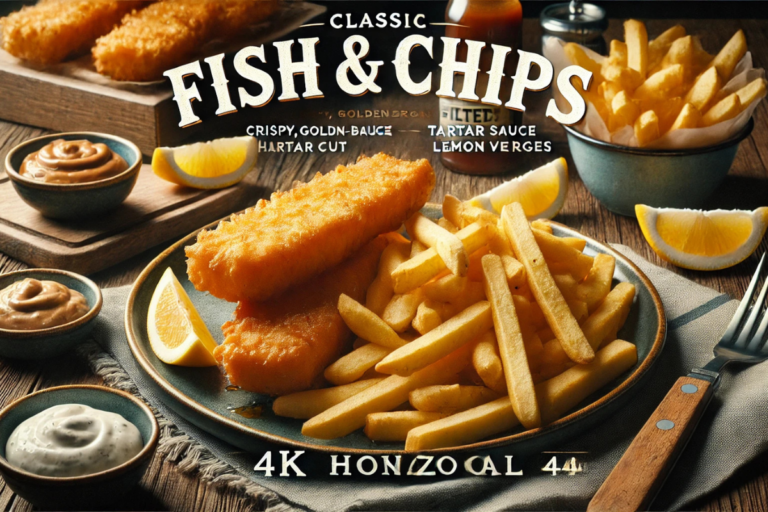Introduction to Fish and Chips
What is Fish and Chips?
Fish and chips is a classic meal that combines fried fish with thick-cut, crispy potatoes, known as chips. The fish is usually coated in a light, crispy batter before deep frying. The chips are fried until golden brown, making them crunchy on the outside and soft on the inside. This dish is famous for its delicious taste and satisfying crunch, making it a favorite comfort food for many. Fish and chips is typically served with sides like tartare sauce, mushy peas, and a slice of lemon.
History of Fish and Chips: How It Became a Classic Dish
The origin of fish and chips goes back to the 19th century in England. It started as a cheap and tasty meal for working-class people. Fish was easy to find due to England’s coastal location, and potatoes were a common crop. The combination of these two ingredients made for a filling and affordable meal. As the dish grew in popularity, small shops known as “chippies” began to sell fish and chips across the country. Over time, it became a beloved national dish in the UK and spread to other countries like Australia, New Zealand, and the United States.
Why Fish and Chips Are Popular Worldwide
Fish and chips became popular because they are simple, tasty, and easy to make. The meal is known for its satisfying crunch and flavor, which appeals to people of all ages. The dish is also versatile – different types of fish can be used, and various seasonings can be added to the batter. Fish and chips are often enjoyed as a street food, making them convenient for people on the go. Today, fish and chips are not only a symbol of British culture but also a favorite meal in many other countries. Its global appeal comes from the fact that it is comforting, familiar, and delicious.
Ingredients for the Perfect Fish and Chips
Best Fish for Fish and Chips: Cod, Haddock, or Others?
To make delicious fish and chips, choosing the right fish is important. The best fish for this dish are cod and haddock.
- Cod: This is the most popular choice for fish and chips. It has a mild flavor and a soft, flaky texture that goes well with crispy batter.
- Haddock: Haddock is also a great option. It has a slightly stronger taste than cod and stays firm even after frying.
- Other Options: While cod and haddock are the top choices, you can also use pollock, halibut, or even tilapia. These fish types have a mild taste, making them suitable for frying.
Essential Ingredients for Fish and Chips
Making perfect fish and chips at home requires simple ingredients. Each ingredient plays a key role in achieving that crispy and flavorful result.
Fresh Fish Fillets
The most important part of fish and chips is the fish itself. Always use fresh fish fillets for the best taste and texture. Fresh fillets make the batter stick better and create a satisfying crunch. Whether you choose cod, haddock, or another type of fish, ensure the fillets are firm and free from any strong smell.
Potato Varieties for Crispy Chips
Potatoes are the other half of this classic dish. For crispy chips, it’s best to use potatoes that are high in starch and low in moisture.
- Russet Potatoes: These are the best for fish and chips. They have a starchy texture that creates golden, crispy chips.
- Maris Piper Potatoes: Popular in the UK, these potatoes also work well. They have a fluffy inside and a crunchy outside when fried.
Before frying, cut the potatoes into thick, even slices. Soak them in cold water for 30 minutes to remove excess starch. This helps make the chips crispier.
Ingredients for Batter: Flour, Beer, Water, and Seasonings
The batter is what makes the fish in fish and chips crispy and delicious. It’s made with just a few ingredients:
- Flour: Plain flour is the main ingredient for the batter. It provides the base and adds a crispy texture when fried.
- Beer or Sparkling Water: Adding beer or sparkling water to the batter makes it lighter and crispier. The carbonation creates bubbles in the batter, making it puff up when fried.
- Water: Cold water can also be used, but beer adds a unique flavor.
- Seasonings: A bit of salt and pepper is added to the batter. You can also add a pinch of paprika, garlic powder, or cayenne pepper for extra flavor.
Mix these ingredients until you have a smooth batter. Make sure it is not too thick or too thin; it should be just thick enough to coat the fish evenly.
How to Make Fish and Chips at Home
Step-by-Step Recipe for Fish and Chips
Making fish and chips at home is simple and fun. Follow this step-by-step recipe for a tasty result:
- Ingredients: You will need fresh fish fillets (cod or haddock), potatoes, flour, beer or sparkling water, salt, pepper, and oil for frying.
- Prepare the Potatoes: Wash and peel the potatoes. Cut them into thick slices for chips. Soak them in cold water for 30 minutes, then drain and dry them with a paper towel.
- Prepare the Batter: In a mixing bowl, combine flour, beer (or sparkling water), salt, and pepper. Mix until smooth.
- Heat the Oil: Fill a deep pan or fryer with oil and heat to 350°F (175°C).
- Coat the Fish: Dip the fish fillets into the batter, making sure they are fully coated.
- Fry the Fish: Carefully place the battered fish in the hot oil. Fry for 4-5 minutes, until golden and crispy.
- Cook the Chips: Fry the prepared chips in the same oil for about 5-7 minutes or until they are golden brown.
- Serve: Place the fish and chips on a plate lined with paper towels to remove excess oil. Serve hot with sides like tartare sauce, mushy peas, and a lemon wedge.
Preparing the Fish: Cleaning, Cutting, and Battering
- Cleaning: Rinse the fish fillets under cold water and pat dry with a paper towel.
- Cutting: If the fillets are too large, cut them into manageable pieces for even frying.
- Battering: Ensure the batter is thick enough to coat the fish. Dip the fillets into the batter, shaking off any excess before frying.
Frying the Fish: Tips for Achieving a Crispy Texture
- Use hot oil (350°F or 175°C) to fry the fish. If the oil is not hot enough, the batter will absorb too much oil and become soggy.
- Avoid overcrowding the fryer, as this can lower the oil temperature and affect the crispiness.
- Fry until the fish turns golden brown, then place on a paper towel to remove excess oil.
Making the Perfect Chips: Tips for a Crispy and Golden Finish
- After cutting the potatoes, soak them in cold water for 30 minutes. This removes excess starch, making the chips crispier.
- Fry the chips twice: once at a lower temperature (around 300°F or 150°C) to cook them through, then at a higher temperature (350°F or 175°C) to make them crispy.
Serving Suggestions: Traditional Sides like Mushy Peas, Tartare Sauce, and Lemon Wedges
- Mushy Peas: Serve warm, adding a touch of mint for flavor.
- Tartare Sauce: Use as a dip for the fish.
- Lemon Wedges: Squeeze over the fish for a fresh, zesty flavor.
Fish and Chips Variations
Healthier Alternatives: Baked Fish and Chips
If you want a healthier version, try baking instead of frying:
- Baked Fish: Place battered fish fillets on a baking sheet lined with parchment paper. Bake at 400°F (200°C) for 12-15 minutes or until crispy.
- Baked Chips: Cut potatoes into wedges, coat with a little olive oil, and bake at 400°F (200°C) for 25-30 minutes, flipping halfway through.
Vegan Fish and Chips: Using Plant-Based Ingredients
For a vegan version of fish and chips:
- Fish Substitute: Use tofu, banana blossom, or battered eggplant as a substitute for fish.
- Batter: Use a flour and water mix with seasonings to make the vegan batter.
- Chips: The traditional chips remain the same but can be baked for a healthier option.
Regional Variations: British, Australian, and American Styles
- British Style: Served with malt vinegar, tartare sauce, and mushy peas.
- Australian Style: Often served with a slice of beetroot or pineapple on the side.
- American Style: Tends to have a thicker batter and is sometimes served with coleslaw or fries instead of traditional chips.
Nutritional Value of Fish and Chips
Calories in Fish and Chips
Fish and chips is known for being a hearty meal, but it’s also high in calories. On average:
- A portion of fish and chips contains around 800-1,000 calories.
- The fish alone (usually deep-fried cod or haddock) provides 300-400 calories, depending on its size and batter thickness.
- The chips contribute around 400-600 calories, based on portion size and frying method.
While it’s not the lightest meal, enjoying fish and chips occasionally is part of the experience.
Health Benefits of Fish: Omega-3 Fatty Acids and Protein
Despite the calories, the fish in fish and chips has some health benefits:
- Omega-3 Fatty Acids: Fish like cod and haddock are rich in omega-3 fatty acids, which are good for heart health, brain function, and reducing inflammation.
- High in Protein: Fish is a great source of protein, which is essential for muscle growth, cell repair, and maintaining overall energy levels. A typical serving provides about 20-25 grams of protein.
Health Risks: Fat Content and Sodium Levels
The main concerns with fish and chips come from the frying process:
- High Fat Content: Deep frying adds fat, particularly saturated fat, to the meal. Too much saturated fat can increase cholesterol levels, so moderation is key.
- Sodium Levels: Salt is often added during frying and after cooking, making fish and chips high in sodium. Excess sodium can contribute to high blood pressure, so it’s best to enjoy fish and chips with less added salt when possible.
Best Places to Try Fish and Chips Around the World
Iconic Fish and Chip Shops in the UK
The UK is famous for its fish and chip shops, often called “chippies.” Some iconic spots to try include:
- The Magpie Cafe in Whitby, known for its fresh fish and crispy batter.
- Poppies Fish & Chips in London, popular for its authentic taste and vintage vibes.
- Anstruther Fish Bar in Scotland, often regarded as one of the best fish and chip shops in the country.
Famous Fish and Chips in Australia, New Zealand, and the USA
Fish and chips are also popular in other parts of the world:
- Australia: Bondi’s Fishmongers and Doyle’s on the Beach in Sydney are well-known spots.
- New Zealand: Mt Eden Village Fish Shop in Auckland serves up fresh and crispy fish and chips.
- USA: In the US, places like Ivar’s in Seattle and Ye Olde King’s Head in Santa Monica are popular for their fish and chips.
What Makes a Good Fish and Chip Shop?
- Fresh Fish: The best shops use fresh, high-quality fish fillets, which are firm and mild in flavor.
- Crispy Batter: Good batter is light, airy, and has a crunchy texture.
- Golden Chips: The chips should be golden brown, thick-cut, and crispy on the outside but soft inside.
- Traditional Sides: Tasty sides like mushy peas, tartare sauce, and malt vinegar complete the experience.
Tips for Ordering Fish and Chips at Restaurants
How to Identify Fresh Fish in Restaurants
When ordering fish and chips at a restaurant:
- Look for Fresh Fish: Ask if the fish is fresh, not frozen. Fresh fish will have a mild smell and firm texture.
- Check the Color: The fish should be white and flaky inside, indicating freshness.
- Ask About the Oil: Fresh oil is essential for good frying. The restaurant should use clean, hot oil for the best flavor.
The Best Sides to Pair with Fish and Chips
Traditional sides can elevate your meal:
- Tartare Sauce: A classic, tangy dip for fried fish.
- Mushy Peas: Soft peas mashed with a bit of mint for a classic British touch.
- Pickled Onions or Gherkins: For an extra crunch and zesty flavor.
- Lemon Wedges: A squeeze of lemon adds a fresh twist to the fried fish.
What to Look for in Batter and Chips: Crunchiness, Flavor, and Texture
- Crunchy Batter: The batter should be crispy and not too thick, adding a satisfying crunch.
- Well-Seasoned Chips: Chips should be seasoned with just the right amount of salt and cooked to a golden brown.
- Light Oil Flavor: The flavor should not be too oily, as this can overpower the natural taste of the fish and chips.
Fish and Chips as Street Food
Why Fish and Chips Became a Popular Street Food
Fish and chips became popular as street food for several reasons:
- Affordable Meal: In the 19th century, fish and chips were cheap and filling, making them perfect for workers looking for a hearty meal on the go.
- Easy to Serve: The dish can be prepared quickly and is easy to wrap, making it convenient for street vendors.
- Delicious and Satisfying: The combination of crispy fish and hot chips is a hit with people of all ages. The crunchy batter, tender fish, and golden chips create a satisfying street food experience.
Today, fish and chips are still enjoyed as street food in many places, from seaside towns to bustling city streets. The dish’s portability and great taste keep it popular as a takeaway option.
How to Eat Fish and Chips: Wrapping in Newspaper vs. Serving in Baskets
Traditionally, fish and chips were served in newspaper wraps. The paper kept the food warm and added a rustic touch to the meal. However, due to hygiene regulations, newspaper has been replaced with greaseproof paper or cardboard boxes, still keeping the traditional look alive.
- Newspaper Wrapping: Adds a nostalgic feel, reminding people of the old days when fish and chips were a common takeaway meal.
- Baskets or Boxes: Fish and chips are often served in paper-lined baskets or boxes today, especially at food festivals or street markets. These modern servings make it easy to carry, keeping the dish hot and crispy.
No matter how it’s served, the best way to enjoy fish and chips is fresh and hot, whether you’re sitting by the sea or in a busy street market.
Cultural Impact of Fish and Chips
Fish and Chips in British Culture
Fish and chips hold a special place in British culture:
- It’s often considered Britain’s national dish, enjoyed by people from all walks of life. It represents a piece of British history and tradition, often associated with seaside holidays and family outings.
- Many Britons have fond memories of eating fish and chips on Fridays, a tradition linked to the Catholic practice of abstaining from meat.
- Fish and chip shops, or “chippies,” are an iconic part of British towns, often found on every high street.
How Fish and Chips Became a Symbol of Comfort Food
Over time, fish and chips have become a symbol of comfort food. It’s a dish that many people turn to when they want something hearty and familiar. Its simplicity, warmth, and satisfying taste make it a go-to option for a comforting meal. It’s not just about the food itself but also the nostalgic feeling it brings to many.
Popularity of Fish and Chips in Pop Culture and Media
Fish and chips have frequently appeared in pop culture and media, showcasing their importance:
- In movies and TV shows, fish and chips are often used to represent British culture, appearing in scenes set in pubs, markets, and seaside towns.
- The dish is often mentioned in literature and is even referenced in classic British songs.
- Fish and chips are also a popular topic in food blogs, TV shows, and travel guides, where they are described as a must-try experience for tourists visiting the UK.
Conclusion
Fish and chips is more than just a meal; it’s a beloved classic that represents tradition, comfort, and simple joy. From its beginnings as affordable street food to becoming a symbol of British culture, this dish has captured hearts worldwide. Its crispy batter, flaky fish, and golden chips offer a satisfying experience that appeals to all ages, whether enjoyed by the seaside, in a cozy pub, or as a quick takeaway.
While it’s not the healthiest option, fish and chips can be enjoyed in moderation, offering a taste of nostalgia with each bite. Whether you’re trying it for the first time or revisiting an old favorite, fish and chips remains a dish that’s both familiar and timeless, celebrated for its unique flavors and enduring charm.


